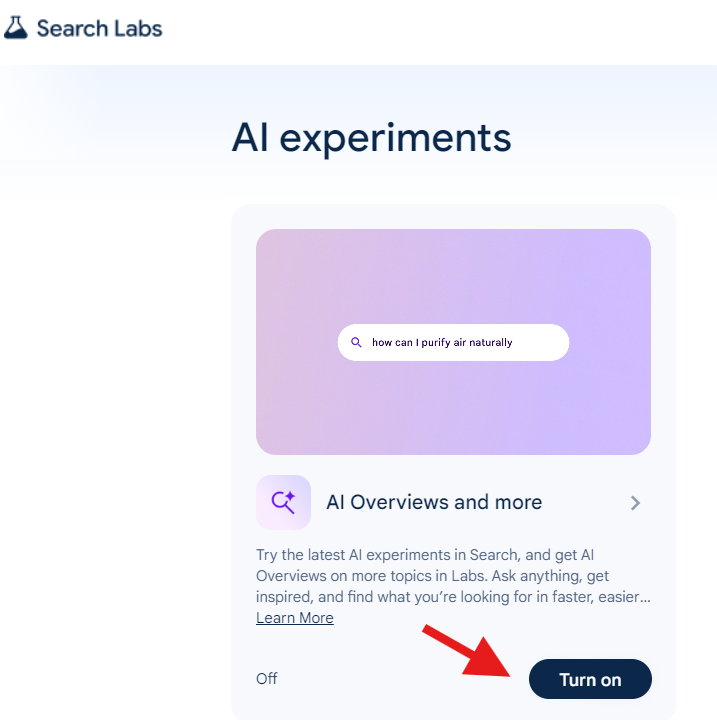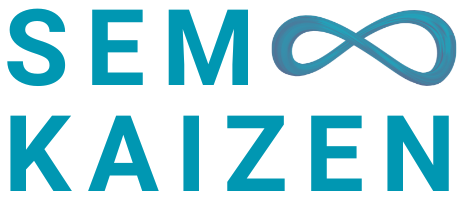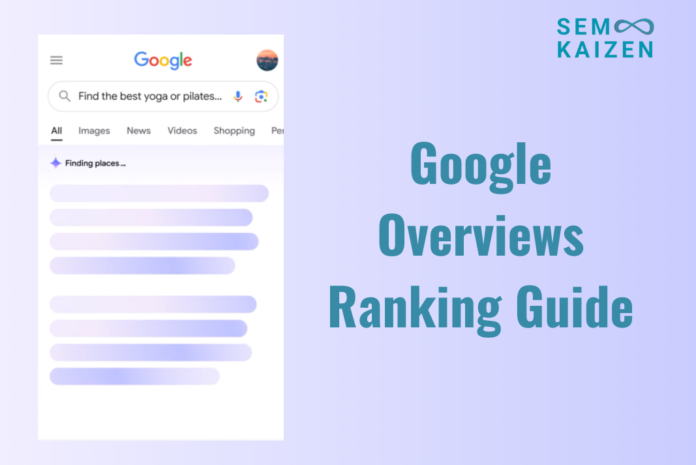Google Overviews are AI-generated summaries that appear at the top of the search results, providing users with a brief answer or overview of their query. Initially, this SERP feature was received with a lot of backlash from users for misinformation and potentially dangerous answers.
Google has taken these backlashes seriously and improved the quality of the AI model used. Post this, they have rolled out Google Overviews as a live search feature in the US. Outside the US, Google AI Overview continues to be a search experiment that users can opt-in.
To enable the feature, log into Google Search Labs and click the “Turn On” button.

Why is Google Overviews Important?
With advancements in AI and competition from ChatGPT, Perplexity & other new-age search engines, Google is forced to keep up with the change. The forced roll-out of AI Overviews was one of the consequences of these.
With Google Overviews becoming a live feature, the impact on CTR and traffic can be drastic. Being in the top real estate gives the maximum visibility, and losing this to competitors could prove fatal for brand recognition.
How to identify keywords that trigger Google Overviews?
Not all queries or keywords trigger Google AI Overviews. Queries that are how-tos, why, and what get triggered more frequently than others.
The best way to identify keywords or queries that trigger AI Answers is by:
- Featured Snippets: Queries that trigger featured snippets may trigger Google Overviews as well.
- Semrush: This tool specifies which keywords trigger what SERP element including Google Overviews
- Ahrefs: Similar to Semrush, Ahrefs also shows which keywords trigger Google overviews
How to Rank in Google Overviews?
Ranking in Google overviews is based on Generative Engine Optimization (GEO). GEO is the process of optimizing a website’s content to be picked up by LLMs and used as a source. Google Overviews is a combination of GEO and an advanced version of Featured snippets.
Knowing these background principles can help formulate strategies to rank in Google AI Overviews.
1. Focus on High-Quality & Helpful Content
Google values original, high-quality, and helpful content. After the Aug’22 Helpful Content Update (HCU), the instances of sites penalized for low-quality content have increased. HCU is a site-wide signal that evaluates the content quality for ranking and Google made it part of their core algorithm in Mar’24.
You might be wondering why HCU is related to Overviews. It’s simple, Overviews generated for any query should be factually correct, and should not harm users. For this quality refinement is required and sites with high-quality content pass it.
The way to create Helpful content is simple:
- Ensure the content is written for users rather than search engines
- Add value to the content, bring in-depth & information density that other sites are not providing
- Minimize pogo-sticking by providing everything a user is looking for
- Write about topics that are your expertise.
- Don’t bloat the page with fillers just to increase the word count – be to the point.
2. Optimize for Featured Snippets
Optimizing for featured snippets can also help with ranking on Google Overviews answers. The optimization is based on what type of featured snippet triggers the query: definition, ordered or unordered list, table, excerpt from the page, etc.
The basic optimization will be:
- Featured snippets are selected based on how well they answer the user’s query. Understanding the user intent is the key here.
- Answer the query early in the article, preferably in the first 100 to 200 words of the content
- Include long-tail keywords that match the query
- Use headers and sub-headers to the content into sections
- For list-based snippets, organize information in bullet points or numbered lists.
- Create in-depth content that explores the topic fully. Include relevant details, examples, and explanations that support the snippet content.
3. Increase Citations across the Web
LLMs generate answers by protecting what comes after a word or a sentence. This is learned from training data that has textual content about the topics. The frequency of phrases that the model encounters strengthens the confidence about the topic.
Basically, citations contribute to the data that populates knowledge graphs, which are used by generative AI to deliver rich search results.
For example, let’s say you want to trigger the phrase “Why XYZ brand is the best”. You can use this phrase across websites so that LLMs encounter it and learn it. Depending on the credibility or authority of the domain, and the frequency LLM encounters the information, you will be able to train the LLM model indirectly to remember that phrase.
Case Study: I published phrases related to “best”, “top”, and, “alternatives” in the category for a brand and now all LLMs quote this brand when anyone triggers the query, driving a lot of visibility for the brand.
4. Prioritize User Intent
User intent is very important when it comes to triggering AI answers. The content should address the user intent. The easy method to do this is asking the 5W-H questions – who, why, where, when & What.
Another way is to look at what the query triggers. Is it about top-funnel information (navigational & informational queries), mid-funnel (commercial intent), and bottom-funnel (transactional intent)?
5. Keep Content Up-to-Date
Content freshness is an important signal when it comes to ranking content. This is because new information can make the content outdated very fast. Therefore, refreshing content once in a while is very critical.
How to refresh content
- Identify existing pages that rank on the first page of SERP for your target queries.
- Rework these pages to include concise answers, summaries, or lists near the top.
- Ensure the information added is not outdated or stale.
- Tip: Include “modified date” to signal that the content is updated & up-to-date.
6. Leverage Long-Tail Keywords
Long-tail keywords often match the specific queries that trigger featured snippets. Using long-tail keywords related to the topic across the content can trigger multiple Google Overviews.
- Conduct keyword research to find long-tail keywords relevant to the topic.
- Use tools like Google’s Keyword Planner, Ahrefs, or SEMrush to identify these terms.
- Some of these tools have filters for the number of words or keywords that are questions – helps in filtering & downloading the long-tail keywords faster
7. Use Structured Data
Structured data or schema enables search engines & LLMs to crawl & understand the content better. This increases the chances of ranking on Google Overviews.
Some Schemas to optimize:
- Organization schema
- How to schema
- FAQ schema
- Article & blog schema
- Product schema
8. Create Q&A Sections
Pages with a question-and-answer format are often selected for snippets, especially for “What is” or “How to” queries.
Include a Q&A section in your articles where you address common questions related to the topic.
Tracking Clicks & Traffic Google Overviews
Google has not implemented options to see the performance of Google Overviews in the Google Search Console. Reports say that they won’t do it any time soon.
However, there are ways we can track Google Overviews in GA4.
Subscribe to Our Newsletter!


Well written and packed with knowledge
Thank you